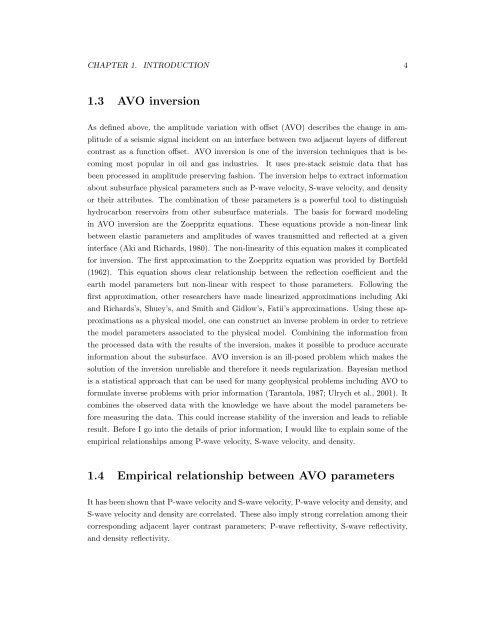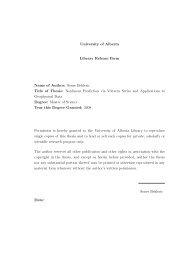Regularization of the AVO inverse problem by means of a ...
Regularization of the AVO inverse problem by means of a ...
Regularization of the AVO inverse problem by means of a ...
Create successful ePaper yourself
Turn your PDF publications into a flip-book with our unique Google optimized e-Paper software.
CHAPTER 1. INTRODUCTION 4<br />
1.3 <strong>AVO</strong> inversion<br />
As defined above, <strong>the</strong> amplitude variation with <strong>of</strong>fset (<strong>AVO</strong>) describes <strong>the</strong> change in am-<br />
plitude <strong>of</strong> a seismic signal incident on an interface between two adjacent layers <strong>of</strong> different<br />
contrast as a function <strong>of</strong>fset. <strong>AVO</strong> inversion is one <strong>of</strong> <strong>the</strong> inversion techniques that is be-<br />
coming most popular in oil and gas industries. It uses pre-stack seismic data that has<br />
been processed in amplitude preserving fashion. The inversion helps to extract information<br />
about subsurface physical parameters such as P-wave velocity, S-wave velocity, and density<br />
or <strong>the</strong>ir attributes. The combination <strong>of</strong> <strong>the</strong>se parameters is a powerful tool to distinguish<br />
hydrocarbon reservoirs from o<strong>the</strong>r subsurface materials. The basis for forward modeling<br />
in <strong>AVO</strong> inversion are <strong>the</strong> Zoeppritz equations. These equations provide a non-linear link<br />
between elastic parameters and amplitudes <strong>of</strong> waves transmitted and reflected at a given<br />
interface (Aki and Richards, 1980). The non-linearity <strong>of</strong> this equation makes it complicated<br />
for inversion. The first approximation to <strong>the</strong> Zoeppritz equation was provided <strong>by</strong> Bortfeld<br />
(1962). This equation shows clear relationship between <strong>the</strong> reflection coefficient and <strong>the</strong><br />
earth model parameters but non-linear with respect to those parameters. Following <strong>the</strong><br />
first approximation, o<strong>the</strong>r researchers have made linearized approximations including Aki<br />
and Richards’s, Shuey’s, and Smith and Gidlow’s, Fatii’s approximations. Using <strong>the</strong>se ap-<br />
proximations as a physical model, one can construct an <strong>inverse</strong> <strong>problem</strong> in order to retrieve<br />
<strong>the</strong> model parameters associated to <strong>the</strong> physical model. Combining <strong>the</strong> information from<br />
<strong>the</strong> processed data with <strong>the</strong> results <strong>of</strong> <strong>the</strong> inversion, makes it possible to produce accurate<br />
information about <strong>the</strong> subsurface. <strong>AVO</strong> inversion is an ill-posed <strong>problem</strong> which makes <strong>the</strong><br />
solution <strong>of</strong> <strong>the</strong> inversion unreliable and <strong>the</strong>refore it needs regularization. Bayesian method<br />
is a statistical approach that can be used for many geophysical <strong>problem</strong>s including <strong>AVO</strong> to<br />
formulate <strong>inverse</strong> <strong>problem</strong>s with prior information (Tarantola, 1987; Ulrych et al., 2001). It<br />
combines <strong>the</strong> observed data with <strong>the</strong> knowledge we have about <strong>the</strong> model parameters be-<br />
fore measuring <strong>the</strong> data. This could increase stability <strong>of</strong> <strong>the</strong> inversion and leads to reliable<br />
result. Before I go into <strong>the</strong> details <strong>of</strong> prior information, I would like to explain some <strong>of</strong> <strong>the</strong><br />
empirical relationships among P-wave velocity, S-wave velocity, and density.<br />
1.4 Empirical relationship between <strong>AVO</strong> parameters<br />
It has been shown that P-wave velocity and S-wave velocity, P-wave velocity and density, and<br />
S-wave velocity and density are correlated. These also imply strong correlation among <strong>the</strong>ir<br />
corresponding adjacent layer contrast parameters; P-wave reflectivity, S-wave reflectivity,<br />
and density reflectivity.









